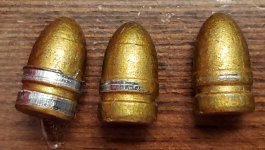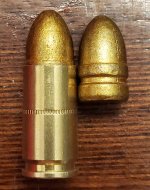First time with lead bullets. 9mm, .356, with the grease groove. I meant to get without the groove, oops. I'm doing some learning and have a few questions.
Do they NEED to be crimped? never crimped 9mm before
they do need flare to seat so do I need to crimp to close the case mouth back up?
The bullet has a shoulder/taper before the grease bands. should this be showing? I would assume it would need to to be able to crimp.
Will the shoulder cause any feeding issues, like a SWC?
With the bullet diameter being smaller until the grease rings, it should not have any plunk (ogive hitting lands) issue right? will this cause any accuracy issues as it could be "jumping" farther. I know this is taken into consideration with rifles, but from my understanding with handguns, as long as it was not hitting it is fine.
Did a few seating tests, need a touch more flare. first 3 tries. last one was not too bad but needs just a bit more.
Seated, 1.127

Pulled, 1st, 2nd, 3rd try, still need a touch more flare

Do they NEED to be crimped? never crimped 9mm before
they do need flare to seat so do I need to crimp to close the case mouth back up?
The bullet has a shoulder/taper before the grease bands. should this be showing? I would assume it would need to to be able to crimp.
Will the shoulder cause any feeding issues, like a SWC?
With the bullet diameter being smaller until the grease rings, it should not have any plunk (ogive hitting lands) issue right? will this cause any accuracy issues as it could be "jumping" farther. I know this is taken into consideration with rifles, but from my understanding with handguns, as long as it was not hitting it is fine.
Did a few seating tests, need a touch more flare. first 3 tries. last one was not too bad but needs just a bit more.
Seated, 1.127
Pulled, 1st, 2nd, 3rd try, still need a touch more flare


